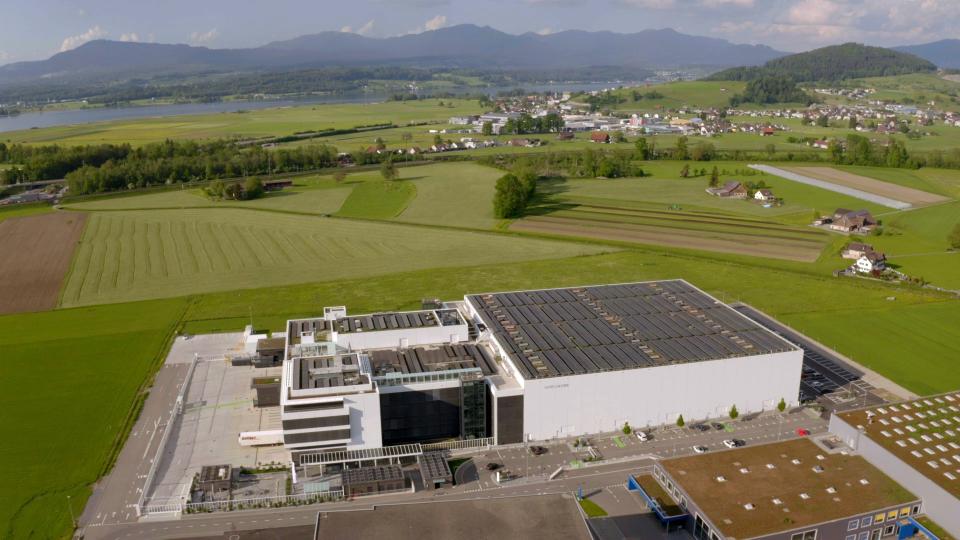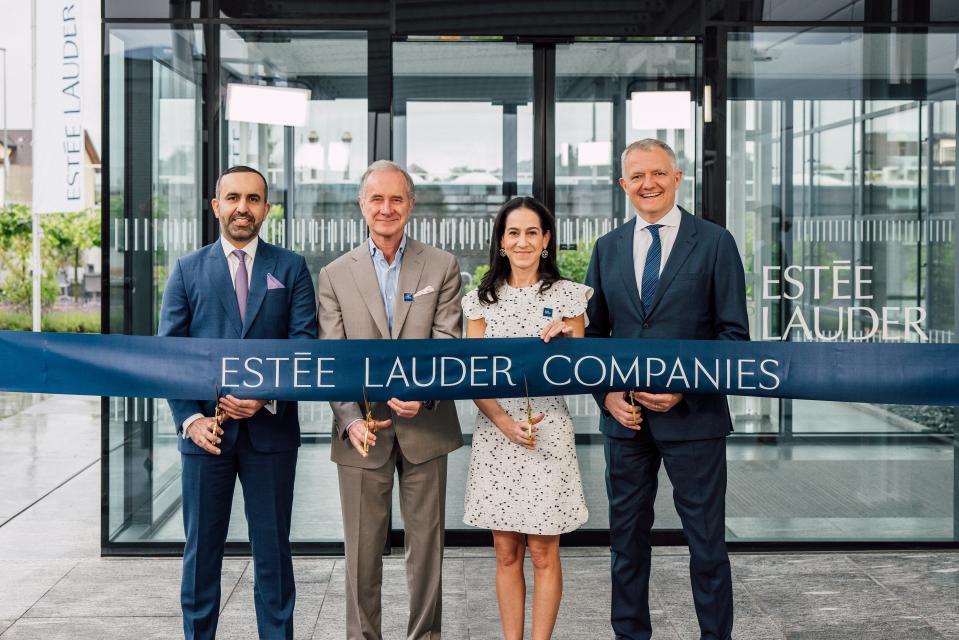Estée Lauder Chief Talks Travel Retail

PARIS — The Estée Lauder Cos. has great expectations for travel retail.
The group just inaugurated a new state-of-the-art distribution center dedicated to the channel worldwide, based in the rolling hills of Galgenen, Switzerland, outside of Zurich. The multistory, sustainably run site occupies 300,000 square feet and doubles the company’s output capacity for travel retail.
More from WWD
Here, automated robots work alongside people in vast rooms, where boxes snake around on conveyor belts. A 65-foot-high, futuristic storage location, appearing like a metallic grid with 11 aisles, can store more than 340,000 trays of boxes.
“This is being created to serve the growth of the travel retail business at Estée Lauder in the future,” said Fabrizio Freda, president and chief executive officer of the Estée Lauder Cos., during an exclusive interview with WWD in Galgenen.
He explained the site is also to service retailers better by increasing not only volumes, but shipment quality, too.
“[It makes] sure that we can adapt to the different retailers and to different markets’ needs in a more efficient way,” Freda said. “That’s the key idea. This is also a way to prepare ourselves to serve this growth in a well-organized and sophisticated way.”
Travel retail, which spans duty free in airports, downtown locations, airlines, cruises and border shops, was the hardest-hit retail channel during the coronavirus pandemic. As the health crisis unfurled starting in early 2020, travel in most parts of the world ground to a complete halt, causing sales in travel-retail locations to plummet.

Courtes of The Estée Lauder Cos.
Pre-COVID-19, in 2019, travel-retail generated $86.3 billion in sales, up 9.8 percent year-over-year, according to Generation Research. Of that, perfumes and cosmetics comprised the largest product category, ringing up about $37.6 billion, representing a 20.1 percent year-over-year gain.
A survey by Generation indicates that duty-free sellers overall should hit pre-COVID-19 sale levels between 2024 and 2025. The recovery has happened faster at Estée Lauder, however.
“Despite the pandemic and many closures in different parts of the world in airports and the limitations to travel, the travel retail channel has been growing for us,” Freda said. “Our travel retail business today is significantly bigger than in 2019.”
Travel retail, which generally touches more than 3 billion consumers a year, is among the group’s fastest growing retail segments.
In its 2021 fiscal year, the Estée Lauder Cos.’ travel retail business generated 28 percent of its overall sales.
The growth has primarily been due to business in China and Hainan Island in particular, which became a tax-free haven for domestic Chinese travelers, who are not allowed to leave the country as part of the government’s “zero COVID-19” policy.
The number of Chinese traveling to Hainan has already outpaced the tens of millions of Chinese traveling abroad in 2019, and therefore almost compensated for the lack of travel in the West, particularly in the early part of the pandemic, Freda said.
Whereas international Chinese travelers tended to come from tier-one and -two cities, those going to Hainan for destination shopping generally hail from tier-three or -four cities, where there is no distribution of luxury goods.
“So they are much more net extra for the industry,” said Freda, explaining: “International travel has always been available to people with a passport [or about 20 percent of the Chinese population], while the domestic duty-free channel is open to the totality of the population.
“I have a point of view that in the future years, when the pandemic abates completely, there will also be international travel to Hainan,” said Freda, describing the island has been having the most luxurious shopping environment anywhere.

Courtesy of David Biedert/The Estée Lauder Cos.
The Estée Lauder Cos. does not have all of its brands in China at present, however.
“There is a lot of growth opportunity in terms of brands, distribution and penetration,” said Freda, calling the company “the market leader in Hainan.”
“Travel retail in general, and Hainan in particular, are very big opportunities for the long term,” he said.
Freda believes the absolute growth of travel retail will be significant, driven by the reboot of international travel; the ongoing increase of traffic coming from emerging markets, such as the Middle East, Brazil and Indonesia, and Hainan.
In the channel, purchase per consumer and the conversion of travelers to buyers are other main growth drivers. The conversion level rises with “pretail.” Freda described pretail as when people with airline tickets purchase products prior to their trips, then pick them up in airports or even on their flights.
“When there is this level of convenience, we know there is an increase — or conversion — of travelers into buyers,” Freda said.
It’s a service already deeply entrenched in Asia, but not yet in the West.
“The better convenience of the model is going to push the purchase per consumer [and] conversion, so we may have an opportunity in front of us to combine the industry’s three drivers at the same time: increased traffic, conversion and consumer purchase across the world,” Freda said. “It is very exciting.”
The Estée Lauder Cos.’ new distribution center is its fourth in Switzerland and justifiable in light of travel retail’s “amazing opportunity,” said Freda, winding the conversation back to Galgenen.
For him, it’s important to have an agile center that can customize distribution models — for example, having the ability to pack big quantities of the same product, or pick one piece per product category for another retailer.
“In order to really participate in this growth, somehow you need to anticipate it,” Freda continued. “Because if you don’t see it coming, it is very difficult at the last minute to react.”
The new Swiss facility’s development also focused on inclusion, sustainability and long-term safety.
In the center, four official languages are spoken. The Estée Lauder Cos.’ Swiss affiliate has 40 nationalities represented. Eighty percent of its leadership and 90 percent of its employee population are made of women.
“The concept of inclusion is taken to the next level,” said Freda, who added heavy lifting by humans has been eliminated in the highly automated Galgenen site.
The center “is built from a flexible and modular perspective,” continued Israel Assa, global president, travel retail worldwide, in a separate, virtual interview broadcast into Galgenen.
The facility, with solar panels on the roof, has been designed to reduce energy and water usage. The building has LED lighting, an energy-efficient HVAC system and solar panels that generate 1,600 kilowatts at peak performance.
A waste management system was put in place to separate out numerous recyclables. Electric trucks remove waste, and wooden waste pallets can produce renewable heating energy.
“We’re expecting to go for LEED certification and obtain it late this calendar year,” said Assa, adding that objective is aligned with the Estée Lauder Cos.’ overarching sustainability goals.
Assa, who was promoted to his role on May 1, said the focus now is on travel retail’s recovery.
“The recovery is definitively happening,” he said. “We’re also focusing on creating touchless, frictionless tech-enabled experiences with our retail partners for our consumers. What’s important is the fulfillment on that promise of this experience, and we’re focusing on the execution of that.”
Assa feels the different stakeholders in travel retail are aligned today and working together to try and enhance the consumer experience.
“We’re in this business not just to have a transaction, but to help make a memory,” he said.
Different product categories sell best depending on the consumer corridor. Luxury and artisanal fragrances, for instance, are leading growth in geographic zones such as the Middle East, Europe, North America and Asia. Luxury skin care remains a top seller in Asia.

Courtesy of The Estée Lauder Cos.
“But makeup is starting to show some really great signs of recovery,” Assa said.
The Estée Lauder Cos. has been in travel retail for 30 years and with operations in Switzerland for more than 55 years.
According to Generation Research’s 2020 data, the company’s travel retail division ranks first market share-wise for beauty, including skin care, makeup, fragrance and hair care.
The Galgenen facility’s official inauguration took place on June 7 and was hosted by Freda and Roberto Canavari, executive vice president, global supply chain, for the group. Also in attendance were Jane Lauder, executive vice president, enterprise marketing and chief data officer, alongside retailers, suppliers and local government officials.
“We are extremely confident in the channel for the long term,” said Freda, during his introductory remarks at the event. “The opening of our new Galgenen distribution center is a testament to this confidence.”
FOR MORE, SEE:
The Estée Lauder Cos.’ Susan Akkad on Gaining Cultural Capital
Evaluating International Opportunities at Estée Lauder Cos.